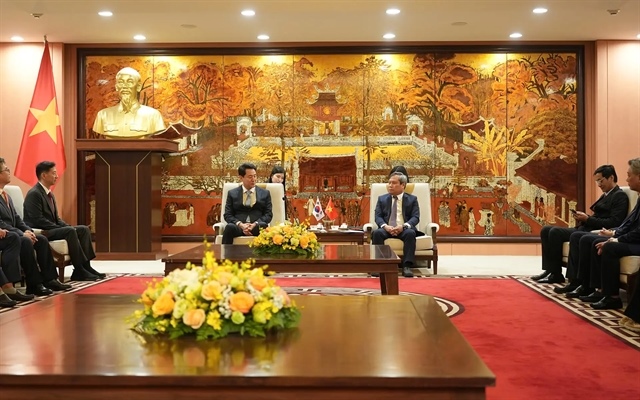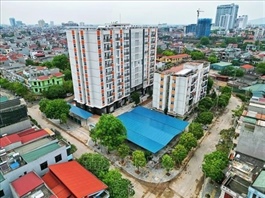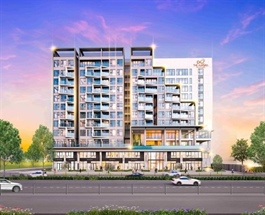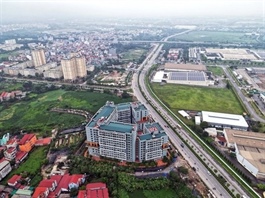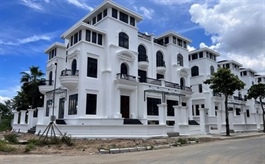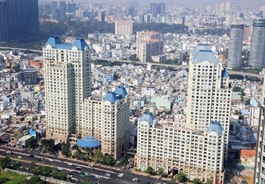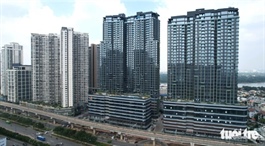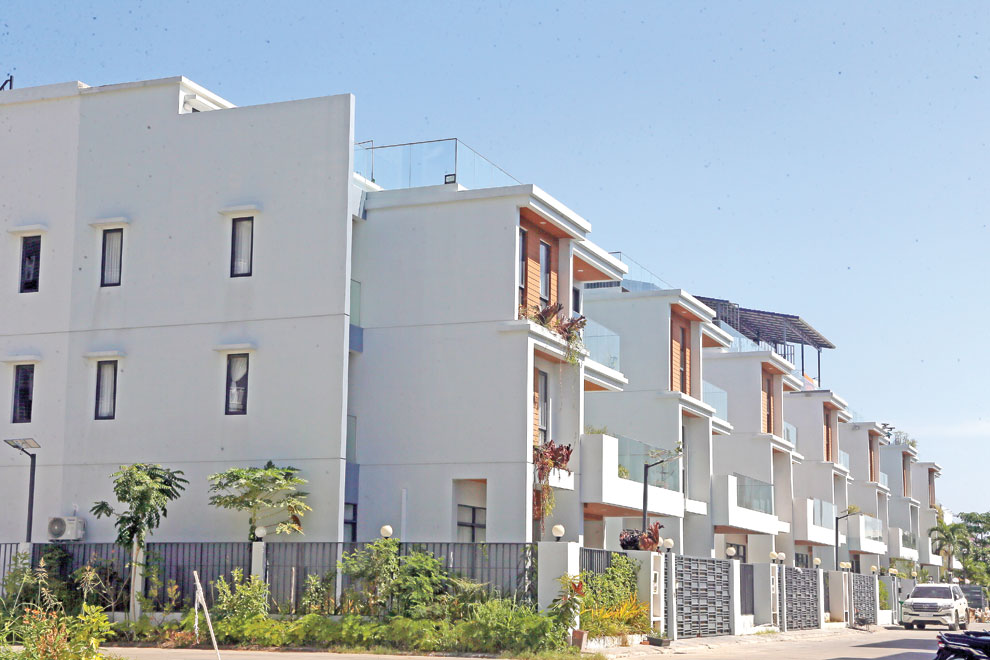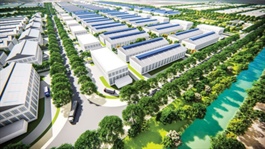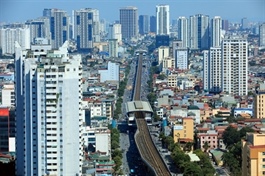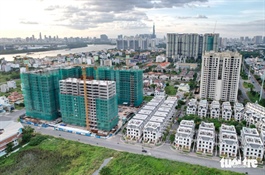Foreign businesses increase green-certified office search
Foreign businesses increase green-certified office search
The green building trend is becoming increasingly dominant, demanded by a larger number of investors and tenants.

Currently, European, Japanese, and Singaporean businesses are actively looking for environmentally friendly office projects, at a time when Vietnam commits to achieving net-zero emissions.
Frasers Property Vietnam (FPV) is the latest developer to earn the highest attainable LEED Platinum certification in operations and maintenance from the US Green Building Council for Melinh Point, an office building in Ho Chi Minh City, in February.
Melinh Point was also the first operational office building in Vietnam to be awarded the Green Mark Platinum certification from Singapore’s Building and Construction Authority.
Tan Boon Thor, general commercial manager and director of Design Management at FPV said that, despite being a building over 20 years old, Melinh Point is now among the most energy-efficient buildings in Vietnam, following comprehensive asset enhancements. “Buildings that achieve LEED certification feature a range of green enhancements in carbon, energy, water, waste, transportation, materials, and indoor environment, all which were incorporated into Melinh Point’s functions,” Thor said.
Enhancement work has focused on incorporating green technologies even from the initial stages of the building’s transformation. Its environmentally friendly design enhancements included the installation of energy-efficient systems such as LED lighting, high-performance heating, ventilating, and air-conditioning system and chiller upgrades to reduce energy usage.
As part of its holistic approach to sustainability encompassing environmental, social, and governance focus areas, Melinh Point’s green facelift extended to tenant engagement on sustainable best practices and sharing green procurement policies and guidelines to encourage greater partnership on a shared sustainability journey.
According to Hoang Nguyet Minh, senior director of Commercial Leasing at Savills Hanoi, European, Japanese, and Singaporean businesses are also actively looking for greener office projects.
Minh said rental demand and the relationship between investors and office tenants will change in the direction of tenants increasingly focusing on high-quality projects, innovative spaces and good operating services to improve the quality of the working environment and meet sustainability criteria.
“Investors have begun to take more proactive moves in building and sustainably operating real estate, especially green office real estate, to satisfy the new requirements of tenants,” Minh said.
She added that the investor has proactively advised on the application of proptech technology, smart building management systems or renewable energy equipment, while improving green criteria and optimizing the monthly operating costs of the house.
“Real estate management will support investors in achieving environmental requirements as, with office buildings developed and put into operation a long time ago, the management system and operating methods may not meet the standards tenants seek,” Minh added.
The current situation
Mark Ridley, general director of Savills Group, assessed that in Vietnam, some of the best office buildings in Hanoi and Ho Chi Minh City that meet green criteria are rated higher than other office buildings. Currently, office buildings with green certificates have rents around 7.5 per cent higher than conventional projects.
“International businesses operating in Vietnam, even listed Vietnamese businesses, need to comply with a number of regulations on meeting environmental, social, and governance (ESG) and net emissions goals. For example, there must be an annual ESG report,” Ridley said. “As a result, demand for office properties will be geared towards buildings that can support them in achieving their environmental requirements. Choosing a building without energy-optimising and carbon-reducing features will become even more costly because the business’s carbon emissions surcharge will be higher.”
At the same time, the positive financial evidence for applying ESG is becoming increasingly clear. As corporate ESG compliance is increasingly monitored and implemented, tenants and investors increasingly prefer and prioritise green buildings, potentially causing buildings to fall short of standards. This faces the risk of increasing vacancy rates.
Meanwhile, Cushman & Wakefield (C&W) has released its Asia-Pacific Office Market Outlook 2024, a comprehensive regional report that includes forecasts of supply, demand, vacancy rates and rents for key cities in the region.
According to the outlook, for many recent new office development projects, the tendency for landlords to focus on sustainability and green elements in buildings is becoming more visible, reflecting ongoing trends in other markets globally, especially Europe and the United States.
According to C&W, just over 20 buildings are certified with LEED/BCA Green Mark in Ho Chi Minh City and Hanoi. Le Hoang Lan Nhu Ngoc, director of Commercial Leasing at C&W Vietnam, said that most projects in the Vietnamese market, new and in operation, are pursuing or have achieved ESG certification, highlighting the recent shift in interest in sustainability.
“This means that hundreds of existing buildings will be pressured to renovate to remain competitive in the market, especially if they want to engage large multinational corporate tenants,” Ngoc said.
Global businesses are making net-zero commitments, so real estate that integrates ESG factors will be key to meeting their goals, Ngoc added.
“Take a technology services company, bank, or insurance company, for example. Up to 80-90 per cent of their carbon emissions can come from real estate, and this is partly why we see tenants shifting their priorities from focusing on location, rent, and amenities to what the building can offer to help them achieve their sustainability goals,” she said.
New office supply
The Hanoi market is expected to welcome about 80,700sq.m of new supply in 2024, mainly located in districts surrounding the city centre. In addition, about 100,000 square metres of new Grade A office space is expected to come into operation over the next few years.
In Ho Chi Minh City, the new Grade A supply expected in District 1 in the 2024–2025 period is located in three projects, contributing nearly 119,000sq.m of high-end office space to market. Approximately 81,000sq.m of additional Grade A supply is also expected to be completed from non-central business district areas before 2027.
Economic instability has affected overall office demand in Ho Chi Minh City as tenants become more and more concerned about costs. The absorption rate will gradually increase from 2024, thanks to new, higher quality supply and improved economic conditions. Office vacancy rate is expected to be above 20 per cent from now to 2026, due to continuous new supply, according to C&W.
Especially, the new supply from Thu Thiem New Urban Area located opposite District 1 marks an important step forward for the submarket to truly become an extension of the current city centre.
In Hanoi, market demand was strong in the first half of 2023, but demand slowed down in the second half and is expected to remain low throughout 2024. The vacancy rate is expected to be at a level of 25–30 per cent this year and then gradually decrease to about 20 per cent in 2027.
With abundant new supply throughout Hanoi, the market is expected to be favourable for tenants in the near future. On average, Hanoi’s total supply is forecast to grow by 3.5 per cent per year in the period 2023-2027, according to C&W figures.
According to the Ministry of Construction, Vietnam boasts around 300 green buildings in all kinds of properties, evaluated and certified by various major certification systems. The country also currently ranks 28th in the world in the number of LEED-certified green buildings.






